
Sunflower (Helianthus annuus L.) is an annual oilseed crop that is globally cultivated. During the 2022/2023 growing season, 28,25 million ha produced more than 55,80 million metric tons, which accounted for 8,41% of the world’s oilseed market (USDA 2023). In South Africa, the average area planted to sunflower and its annual yield since 2007 were recorded at 565 563 ha and 740 832 tons respectively.
Sunflower oil is one of the major vegetable oils used in the food industry. Moreover, with its high quality, edibility and high protein content, it is often used in the production of various commercial products. Sunflower is generally grown under rain-fed systems due to its moderate drought tolerance. This drought tolerance can be attributed to its well-developed and deeply penetrating root system that allows the plant to use available soil nutrients and moisture more effectively. However, from the early flowering stage up to grain filling stage, sunflower is particularly sensitive to water and heat stress.
Environmental factors, including temperature, day length, intercepted solar radiation, and precipitation, have varying effects on sunflower growth and developments throughout its life cycle. Fluctuations in temperature and moisture availability affect both the quantity (grain weight) and quality of oil accumulation in sunflower. Therefore, various cultural practices are implemented to counter negative effects. Among these practices, the implementation of a specific planting date and nitrogen (N) fertilisation are some of the most critical factors in successful sunflower production.
N fertilisation
N is one of the essential nutrients for sunflower growth and development and constitutes structural and metabolic elements of plant cells, such as amino acids, proteins, nucleic acids, and enzymes.
Sunflower absorbs N mainly in inorganic forms such as ammonium (NH4+) and nitrate (NO3–). Upon N absorption, the vegetative growth of plants is stimulated, favouring the synthesis of photo assimilates and by-products for fruit and seed formation. Studies suggest an increase of sunflower seed and oil productivity of up to 40% when supplemented with N sources.
Several international studies reported that a 100 kg N/ha application is optimum for sunflower production. The application of N below or above the optimum range, however, reduces the effective use of this nutrient by the crop, leading to a decline in yield.
The application of excessive N dosages will, for instance, stimulate plant growth (height) to such an extent that the risk of lodging in areas prone to excessive winds increases significantly. Furthermore, an imbalance between the vegetative and reproductive phases of the crop can occur during these circumstances when uncontrolled vegetative growth is stimulated and plant maturation delayed. This leads to a reduction in yield and an increase in pest susceptibility. Studies also reported a reduction in oil content and seed yield at a 150 kg N/ha application rate.
Some studies, on the other hand, reported that 80 kg N/ha was sufficient, while others showed that an increase in N levels lead to steady increases in yield, protein content and linoleic acid simultaneously with a decrease in oil content and oleic acid percentage.
Little or no research has been conducted in South Africa, however, to quantify the optimum N application for local sunflower production conditions. This article will bring some insight on the research currently done by ARC-Grain Crops to address this lack of local information and provide valuable information on N fertilisation and planting date effects on seed yield and oil content.
Planting date
The semi-arid Free State and North West provinces, with unpredictable and adverse weather conditions during the production season, account for approximately 80% of the total sunflower cultivation area in South Africa. Consequently, these weather conditions can exert significant influence on seed yield and oil content. Late sunflower plantings are also more likely to encounter adverse conditions, including seed or seedling exposure to high December and January temperatures, while pollination and seed development will occur under rapidly decreasing temperatures.
On the other hand, the optimum planting time of this crop allows maximum use of all of the natural resources in line with optimal environmental conditions and physiological growth stages of the crop that will ensure good seed germination and seedling establishment, optimum root system development, growth and yield. Plants will be enabled to establish themselves better and absorb essential nutrients from a large volume of soil. In South Africa, sunflower is typically planted from November to mid-January. If these planting dates are delayed, sunflower grain and oil yields are greatly reduced.
Research on N fertilisation and planting dates
The aim of the ARC-Grain Crops study was to determine the effect of N fertilisation on sunflower yield when planted at the optimum (mid-December) and late (after mid-January) planting dates. To achieve the aim, two field experiments were established at ARC-Grain Crops’ Potchefstroom research farm over two growing seasons (2020/2021 and 2022/2023). The first planting date (planted on 15 December during 2020 and 2022, respectively) was considered the optimum planting date. The second planting date (on 26 January 2021 and 18 January 2023, respectively) was considered as late.
Five sunflower hybrids, including two conventional (PAN 7080 and AGSUN 8251), two Clearfield (AGSUN 5106 CLP and PAN 7160 CLP) and one high-oleic hybrid (PAN 7158 HO), were planted to study these effects on. Five different levels of N fertiliser were applied, including the control that received no N fertilisation. N fertilisation treatments included i) 45 kg/ha N as a basal application at planting and ii) 45 kg/ha N one month prior to planting. This was followed with a topdressing one month after planting applied at iii) 0 kg/ha, iv) 45 kg/ha (total of 90 kg/ha) and v) 75 kg/ha (total of 120 kg/ha) (see Table 1). Based on soil analysis prior to planting and local sunflower production recommendations, no additional phosphate (P) and potassium (K) fertilisers were required in any of these trials. The trials were planted in a randomised complete block design with a split-plot arrangement and four replications.
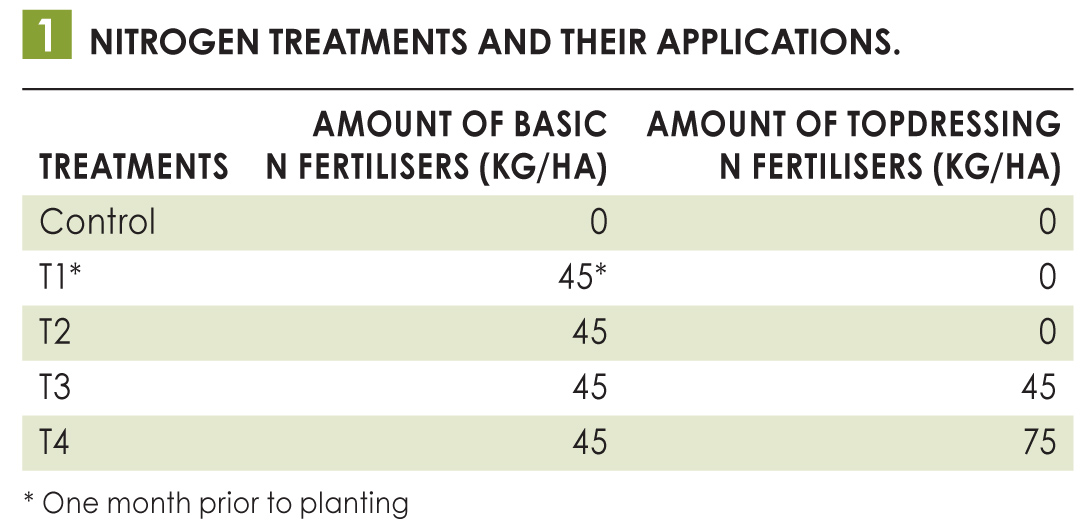 Effect of planting date on seed yield, oil content and oil yield
Effect of planting date on seed yield, oil content and oil yield
The effect of the two planting dates on the sunflower seed yield, oil content and oil yield during these two growing seasons, are provided in Table 2. During the 2021/2022 growing season the optimum planting date yielded 2,39 t/ha compared to the 1,77 t/ha produced at the late planting date (25% reduction in yield). The 2022/2023 growing season showed a similar trend where the first planting date produced 2,3 t/ha, while the late planting produced 1,85 t/ha (19% reduction in yield). These results confirm that of other studies indicating that early/optimum planted sunflower produced higher yields than those planted later.
 In 2020/2021 the second planting date yielded a 5% and 4% (2022/2023) higher oil content than that yielded during the optimum planting dates (Table 2). However, the oil yield of the sunflower planted in December (0,93 and 0,91 t/ha, respectively) were higher than that from the January planting dates (0,73 and 0,75 t/ha, respectively). These results are a clear indication that when planting dates are delayed until the last week of January, the oil yield will be reduced.
In 2020/2021 the second planting date yielded a 5% and 4% (2022/2023) higher oil content than that yielded during the optimum planting dates (Table 2). However, the oil yield of the sunflower planted in December (0,93 and 0,91 t/ha, respectively) were higher than that from the January planting dates (0,73 and 0,75 t/ha, respectively). These results are a clear indication that when planting dates are delayed until the last week of January, the oil yield will be reduced.
Effect of N on seed yield, oil content and oil yield
The different N applications and planting dates had a highly significant effect on sunflower seed yield during both growing seasons (Graph 1). The 120 kg N/ha, applied as 45 kg/ha at planting and 75 kg/ha as topdressing, produced the highest seed yield at the optimum planting date (2,87 and 2,90 t/ha) and at late planting date (2,14 and 2,19 t/ha) during the 2020/2021 and 2022/2023 growing season respectively (Graph 1).
The 90 kg N/ha (45 kg/ha at planting and 45 kg/ha as topdressing) performed second best in terms of seed yield, but no significant differences existed between the 45 kg/ha applied one month before planting and the 45 kg/ha applied at planting. The seed yield was lowest where no N was applied at the optimum and at the late planting date, for both growing seasons: 1,85 and 1,46 t/ha during 2020/2021 and 1,47 and 1,36 t/ha during 2022/2023) (Graph 1).
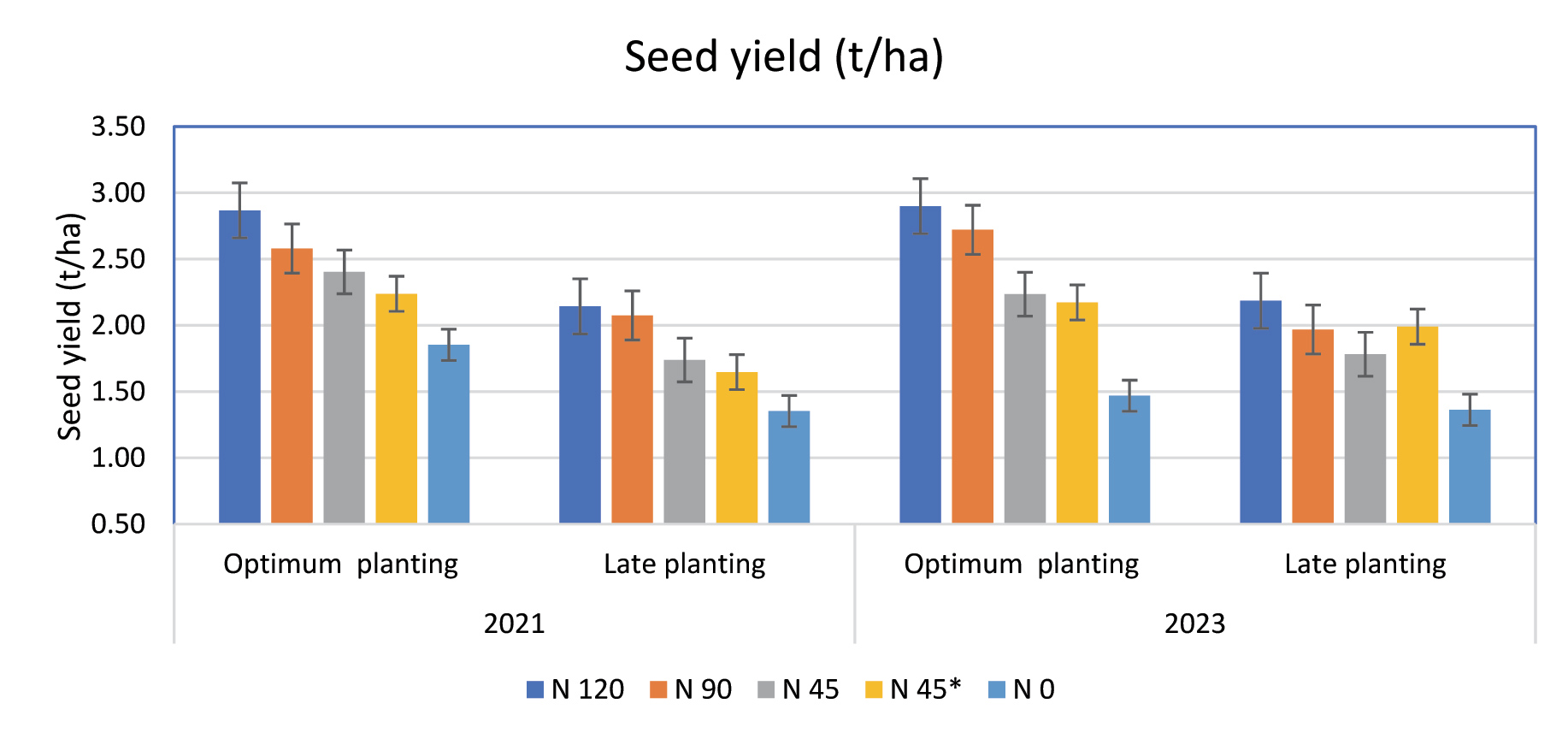
Oil content
During the 2020/2021 growing season, the highest oil content was yielded at the optimal planting date where no N was applied (40,42%) and at the 45 kg N/ha applied one month before planting treatment of the late planting date (42,03 %) (Graph 2). The lowest oil content (37,5% and 39,68%) was recorded at the 120 kg N/ha application from the optimal planting date and the late planting date, respectively. Plants planted at the optimum planting date showed no significant differences in oil content at the 45 kg/ha N application applied at planting and that applied one month prior to planting treatments. However, when planted at the second planting date, plants that received the 45 kg N/ha application prior to planting had a higher oil content than those where 45 kg N/ha were applied at planting.
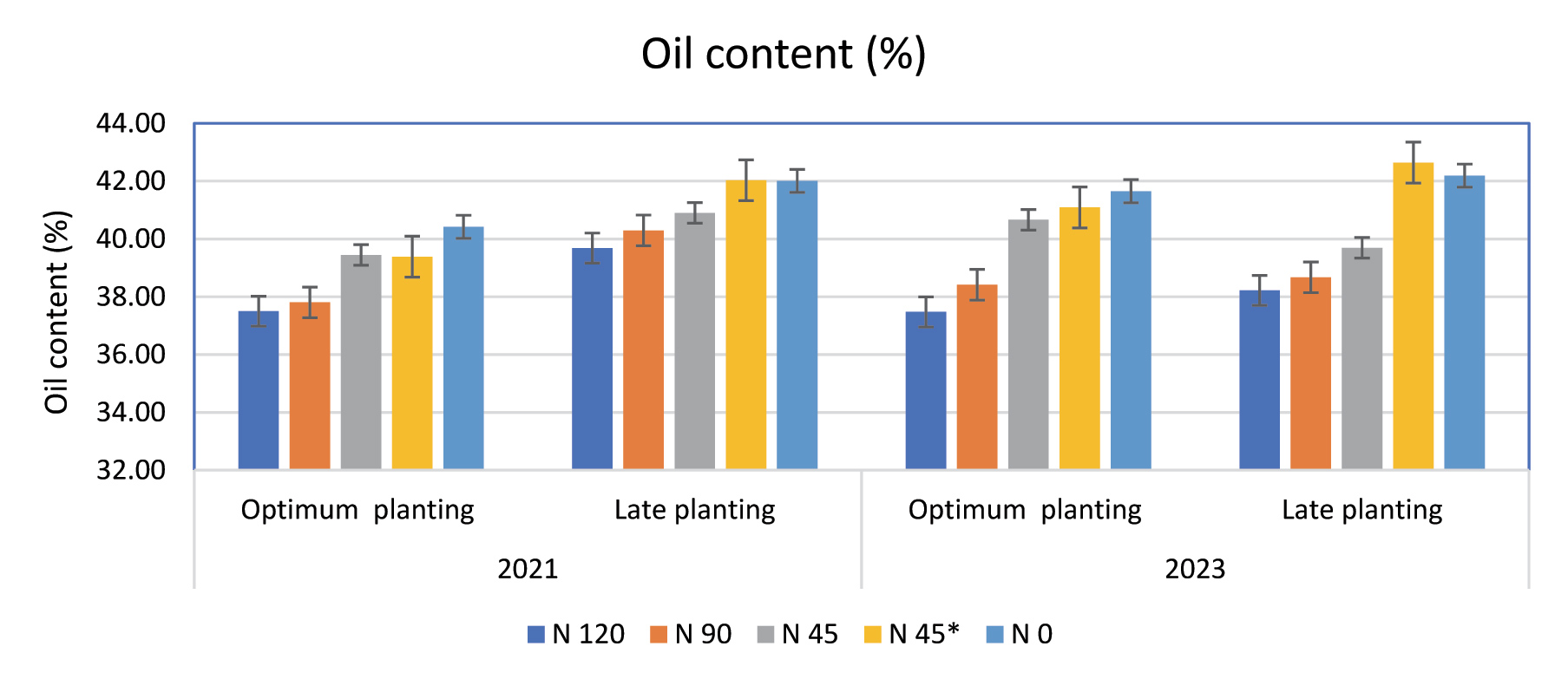
During the 2022/2023 growing season the highest oil content was recorded at the zero N application (41,65%) from plants planted at the optimum planting date and from those at the 45 kg/ha applied one month before planting (42,64 %) at the late planting date. Both planting dates yielded the lowest oil content at the 120 kg N/ha treatment. These results confirm that of other studies that showed a decrease in oil content where N rates were increased.
Oil yield
During the 2020/2021 growing season, the 120 kg N/ha treatment yielded the highest oil yield for the optimum (1,08 t/ha) and late (0,86 t/ha) planting dates followed by those from the 90 kg N/ha treatment (Graph 3). The lowest oil yield was produced when no N was applied.
During the 2022/2023 growing season the same trend was evident. The 120 kg N/ha yielded the highest oil yield for both the optimum (1,10 t/ha) and late (0,86 t/ha) planting dates followed by 90 kg N/ha for the optimum planting date and 45 kg N/ha applied prior to planting at the late planting date (Graph 3). The lowest oil yield was recorded at both planting dates from plants that received no N application.
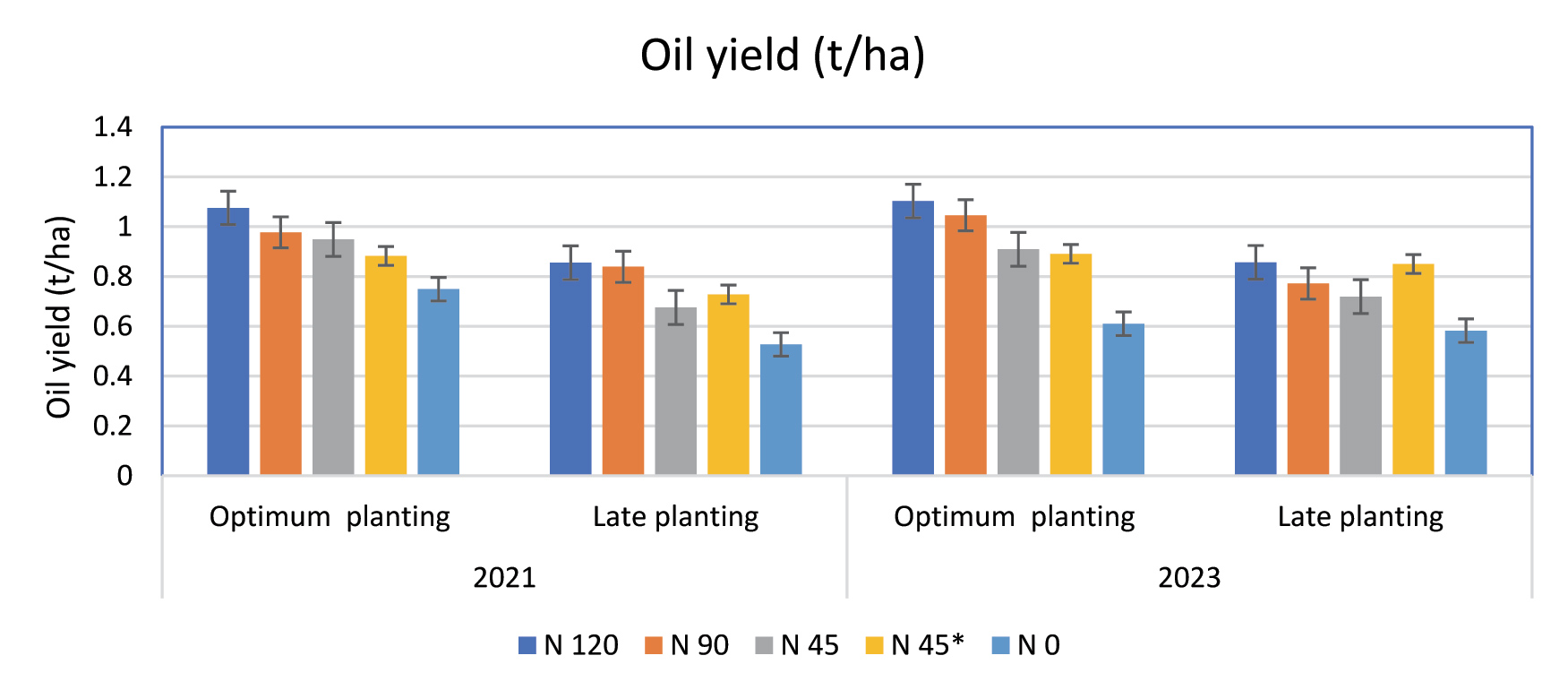
Indexes of nitrogen use efficiency
Nitrogen agronomic efficiency represents the ability of a plant/cultivar to increase yield in response to the N applied and is used as a short-term indicator of the nutrient’s impact on crop productivity. The agronomic efficiency (AE) is calculated in units of yield increase per unit of nutrient applied and reflects the direct production impact of an applied fertiliser related to economic return. To calculate AE the following equation is used to determine the yield (kg) gain per kilogram fertiliser applied:
Agronomic efficiency (AE) = (grain yield of fertilised crop – grain yield of unfertilised control)/fertiliser applied. The AE equation indicates the yield gain (in kg) per kilogram fertiliser applied (Mengel et al. 2006).
The highest AE values were calculated at the 45 kg N/ha treatment of the optimum planting date (14,36 kg/kg) and the 45 kg/ha (10,26 kg/kg) applied one month before planting treatment of the late planting interval (Table 3). At the optimum planting date an increase of 14,63 kg yield per kilogram N fertiliser was observed, while at the late planting date an increase of 10,26 kg yield per kilogram N fertiliser was observed.
 Best return on investment (ROI)
Best return on investment (ROI)
The correct use of fertilisers can yield huge returns on this investment (Table 4). During the 2020/2021 and 2022/2023 growing seasons, the 45 kg N/ha applied at planting during the optimum planting date and 45 kg N/ha applied one month before planting during the late planting date achieved the best ROI. A 45 kg N/ha application is equal to 98 kg of urea.
 Conclusion
Conclusion
The planting date and different N levels applied at different times have a significant effect on sunflower production. When planting later (after mid-January) than the optimum planting date (mid-December), a 19% to 25% reduction in seed yield was recorded. Furthermore, the highest seed yield was achieved at high levels of N application (120 kg N/ha) whether planting at the optimum date or the late date. However, in terms of nitrogen AE and best return on investment, 45 N kg/ha applied at plant when planting at the optimum planting date and the application of 45 N kg/ha a month before plant when planting on a late planting date performed the best.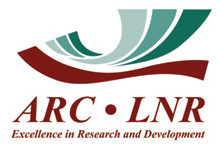
Acknowledgements
The author wishes to thank the Oil and Protein Seeds Development Trust and the Agricultural Research Council for the funding of this project and the sunflower team at ARC-Grain Crops for their technical assistance.



























